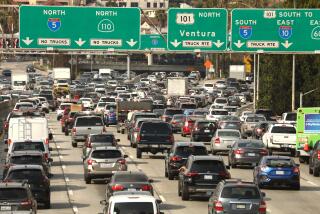Travelers May Just Press a Button to Drive Into Future : Technology: Transportation conference gathers engineers and other specialists for a brainstorming session on how to get people from here to there.
- Share via
COSTA MESA — Imagine getting into your car, pressing a button and having it take you to San Francisco. Or glancing at a screen on your dashboard to check out traffic conditions ahead. Or being awakened by an automated voice when the car senses you are drowsing.
These were among the traffic innovations of the future discussed Wednesday during the annual Future Transportation Technology Conference and Exposition, a four-day gathering that ends today at the Red Lion Hotel/Orange County Airport.
For the record:
12:00 a.m. Sept. 1, 1995 For the Record
Los Angeles Times Friday September 1, 1995 Orange County Edition Metro Part B Page 3 Orange County Focus Desk 2 inches; 54 words Type of Material: Correction
Auto future--An Aug. 10 story about the future of automobile transportation incorrectly attributed a quote about the work of the National Automated Highway System Consortium. The comments were made by Roger D. Fruechte, head of the Vehicle Systems Department at General Motors Corp. The story also misstated the membership of the consortium. It is made up of nine companies, led by GM.
Sponsored by the Society of Automotive Engineers, the event has attracted more than 500 engineers, managers, academics and government officials from around the country for a massive brainstorming session.
“It’s an exchange of technical information,” said David L. Schwartz, a spokesman for the society. “There are a lot of people working on future technologies and they want to find out if they’re on the right track. We provide the platform for them to talk to each other.”
Conference participants said much of the future commuting technology is already under development by major consortiums.
“There are no show-stoppers here,” said Gene Farber, a manager at Ford and member of the National Automated Highway System Consortium, a group of nine major car companies which, he said, expects to have a prototype of an automatic driving system up and running by 2001. “The technology is already here; the only question is whether there’s a market.”
On a limited scale, Farber said, such a market is now being developed. Avis Rent A Car and Oldsmobile already provide cars equipped with dashboard computers that monitor a car’s location and give drivers turn-by-turn voice instructions on how to reach a designated destination.
How much of a leap does it require, he asked, to imagine such cars linked by radio to the electronic highway sensors already monitoring traffic conditions on major urban roads? The result could be on-board computers that plan a driver’s route based on traffic conditions at the moment.
And how long before those same computers could be programmed to actually drive your car? Of course, Farber said, that would require a new series of highway devices to sense when a car is veering one way or the other and turn it accordingly. It would also require on-board front and rear radar systems to “see” other cars and automatically adjust speed to avoid collisions.
“You could have vehicles following each other at three-foot intervals traveling at 65 miles per hour,” he said. “It would improve safety and quadruple the use of the highway.”
But he said intermediate steps are likely to be implemented first: Miniaturized video cameras, for instance, that would detect eye closure to wake up drowsy drivers. Or collision avoidance systems that would beep when a car is overtaking another one at a rate likely to result in an accident.
“It’s all still very iffy,” Farber said. “No one is sure how much of it will get developed.”
Roger Fruechte, head of the vehicle systems department at General Motors’ Research and Development Center, agreed. “The big question is if the consumer is willing to buy it,” he said. “And how much is he willing to spend?”






